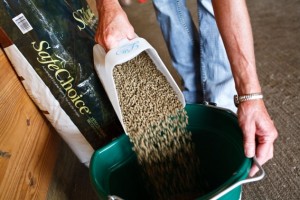5 Key Lessons in Equine Nutrition and Management: Insights from a Feed Company Insider

I am fortunate to count myself among those who grew up with horses. My mother had grown up with a horse as her pet (Babe was her name). Much of what I learned came from how she had managed her horse. This meant that I grew up with a…how to say…’traditional’ mindset about nutrition; ‘hay and sweet feed now and then is all any horse needs’ and that is what my horse was fed…until I started working for a feed company. Then, my nutritional education hit the fast lane! Here are the top 5 things I have learned about equine nutrition and management since working for a feed company.
1.The Purpose of Feed: Unveiling the Nutritional Power
Growing up, we’d use feed as bait to bring the horses off the pasture, a reward after a good ride (after properly cooling out of course) or on very cold days, but certainly not every day. Most feeds are designed to provide a horse with the nutrients that hay or pasture alone cannot. Many people think of feed as simply providing ‘energy’ which, many of them do. When it comes to feed, you generally get what you pay for. So very often, the less expensive feeds are designed to provide the minimum amount of nutrition. That’s why it’s important you select the right feed for your horse so that they are getting the balance of nutrients that fit their needs, be it energy, biotin or high quality proteins, fed consistently. Once you find the right nutrition for you horse, you might be amazed at how good they look and how happy they seem.
2.Cost-Effectiveness of High-Quality Feed: Investing in Optimal
I used to feed an inexpensive sweet mix to my horse and spent my money on supplements to provide what the feed didn’t, as opposed to feeding her a fully fortified feed. For the most part, a high quality, fortified feed that is fed at the right amount removes the need for most supplements and, you might be surprised to find it can be cheaper. There are a few exceptions where it is either illegal or extremely difficult to include specific nutrients in a feed. Joint support, for example, is difficult to solve. It is against the law to include any ingredient that is considered a drug in horse feed. In those instances, it does make sense to add a supplement to provide what the feed can not.
3. Feeding Directions: The Key to Proper Equine Nutrition
Feeding directions matter! Most feeds are formulated to provide a specific concentration of nutrients based on the pounds (not scoops) that are fed. This is a ratio of your horse’s weight. In order to feed at the recommended levels, you need to know how much your horse and feed weighs. Growing up, we just fed a ‘scoop’ regardless of the horse or feed. Taking this approach will often mean under or over feeding your horse.If your horse’s body condition is not ideal despite following recommended feeding levels, reconsider the feed you are using.
4. The Value of Added Nutrients: Unleashing the Benefits
I used to think that the extra ‘stuff’ provided in a fully fortified feed was just tag dressing. One of my biggest ‘ah ha’ moments came when I realized that (at least with Nutrena feeds) it’s not just adding another line to the guaranteed nutrients tag; it’s really providing a benefit to the horse. I saw it when I switched my horses away from a local mill sweet mix. Adding the little things visibly improves hoof quality, hair coat, and even muscling.
5. Individualized Equine Nutrition: Knowing Your Horse
Horses are individuals; as a rider, that is evident. However, I used to think that when it came to nutrition, there was very little variation. How wrong I was! Unlike production animals, humans have been selectively breeding horses for attributes other than feed efficiency. Therefore, the general horse population has a wide range of nutrition needs from the easy keeper to the hard keeper and everything in between. Staying closely tuned into your horse, changes in his performance, attitude and body condition score throughout the year and how he reacts to his feed and forage is all part of managing him as an individual. When his job changes (increase or decrease in workload) or he reaches the next life stage, it’s important to reevaluate his feeding program to provide him what he needs.
